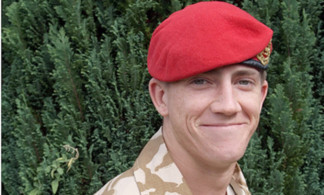
Ex-Army commander verbally attacks military chiefs.
A former senior Army commander used as a “poster boy” for the Afghanistan war has demanded a public apology for a soldier’s death in a scathing attack on military bosses.
Major Richard Streatfeild, 40, who the Ministry of Defence made the face of the Afghanistan campaign, was a commanding officer in the insurgent stronghold of Sangin during some of its most fierce fighting.
But Mr Streafeild has broken his silence to claim troops lacked equipment and training for the deadly campaign they waged.
And he has demanded an apology for the “blue on blue” death of 22-year-old Lance Corporal Michael Pritchard during the 2009/10 winter tour, because he believes his life could have been saved with better equipment.
Mr Streatfeild who commanded A Company, 4 Battalion, The Rifles during a seven-month tour, said: “It’s true to say we were the best trained we’d ever been, and we did have the best equipment we’d ever had.
“But it is also true to say it wasn’t good enough in relation to the operation we were going on and the tasks we were asked to do.
“Undoubtedly the core equipment has been found to be inadequate.
“Before I went out there I felt ready. Hindsight suggests we were far from the finished article.”
Mr Streatfeild said he was most ashamed of publicly defending the kit provided during training and on operations commanding British troops in Helmand province.
He lost five men during the tour, and said poor communications between platoons due to a lack of radios contributed to the death of Mr Pritchard, who was killed by a British sniper in what remains one of the most controversial friendly-fire incidents of the 13-year campaign.
He also claimed the Army gave misleading evidence at his inquest.
He said the MoD assured East Sussex coroner, Alan Craze, that it had learned lessons from Pritchard’s death and that there were plans to buy the “battlefield beacon” which would have identified Pritchard and probably saved his life.
“That (evidence) was only half true,” said Streatfeild. “The army knew the money wasn’t there.
“This was a critical moment of the inquest. The money had already been identified as not going to be spent.”
Mr Streatfeild said Pritchard’s mother, Helen Perry, should get a formal apology from the MoD.
He said: “I stand wholeheartedly behind her on this. We take the plaudits when things go right, so you have to take responsibility for things that don’t go right.
“For me this falls within the military covenant. It is the honourable thing to do and it requires a bit of moral courage on behalf of the chain of command.
“Clearly there were mistakes, and frankly it is just good manners to own up to them, particularly when you have done something wrong that has caused this much upset and hurt.”
An MoD spokesperson said: “Our thoughts remain with the family and friends of Lance Corporal Michael Pritchard.
“The circumstances which led to LCpl Pritchard’s tragic death were fully investigated and the standard operating procedures used in Afghanistan were changed as a result.
“The armed forces constantly review equipment requirements to ensure they are best placed to meet the myriad threats faced on operations.
“In Afghanistan, we encountered a number of new and evolving threats that required different tactics and new, specific kit to be designed and deployed.
“Since 2003, the Urgent Operational Requirements process has delivered more than £5.8bn worth of world-class equipment to the frontline quickly, including thousands of vehicles, personal protection and counter-IED technology that has saved countless lives.”

Enjoy the convenience of having The Sunday Post delivered as a digital ePaper straight to your smartphone, tablet or computer.
Subscribe for only £5.49 a month and enjoy all the benefits of the printed paper as a digital replica.
Subscribe